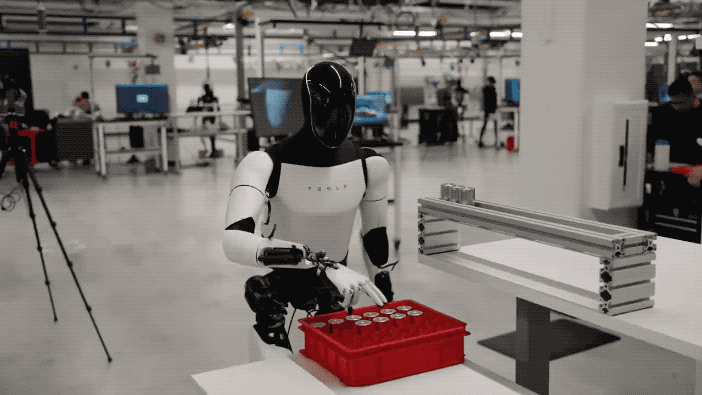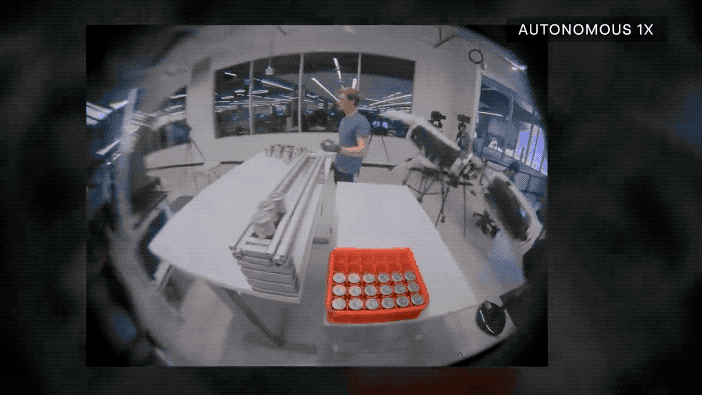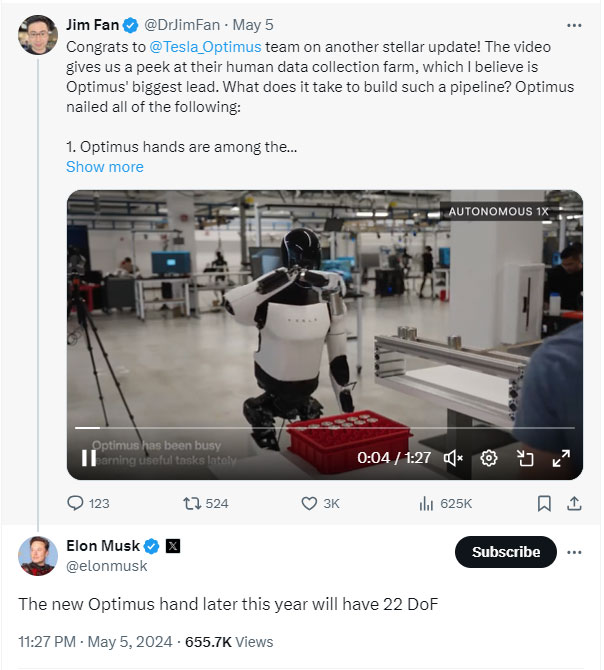How are humanoid robots working in Tesla's factory?
Optimus, first introduced by Tesla in 2021 , is a humanoid robot with ambitions to revolutionize the automation industry.
The latest video about Tesla's Optimus robot is spreading quickly on social networking sites and at the moment it seems to be being used in Tesla's factories to sort batteries. 4680 by Tesla).

In 2021, Elon Musk surprised the world by introducing Optimus, a humanoid robot designed to revolutionize the automation industry. With a bold ambition to become "the most useful robot in the world" , Optimus promises to bring great potential to many different fields.
One of the highlights of this launch video is that Optimus completes this job in the factory in a completely automated way, with no human intervention during the work process.
And from Optimus's perspective, it can also pick up and put the spilled battery back in its correct position.

Optimus can work continuously, without needing to rest, and can perform tasks with high precision, helping to increase efficiency and productivity in many fields. At the same time, using robots can help reduce labor costs and operating costs in the long term.
Regarding Optimus's hand, Nvidia scientist Jim Fan gave many compliments such as: "The Optimus hand is among the most dexterous five-fingered robotic hands in the world. It has a tactile sensor, 11 orders of magnitude." (DoF) compared to many competitors with only 6-7 DoF and the ability to withstand many interactions with objects without constant maintenance.".
And right below Jim Fan's comments, Musk also appeared and revealed even more important news revealed by Elon Musk himself: "By the end of this year, Optimus' hand will have 22 degrees of freedom."

DoF refers to the amount of independent movement a joint can perform. A higher DoF number will allow for more complex and seamless movements.
First of all, in terms of neural networks, we can know from the subtitles in the video that Tesla deployed an end-to-end neural network to Optimus to train the battery classification task.
Therefore, the data used by Optimus only comes from 2D cameras and tactile sensors that adjust the force of the hand, and directly create joint control sequences.

Optimus is expected to have many applications in many different fields, including: Production support; Customer service; Health care; Agriculture.
Tesla engineer Milan Kovac further revealed that this neural network runs entirely on the robot's FSD computer and is powered by a built-in battery: "As we add more diverse data in the process training, a neural network can perform multiple tasks".
According to the company, training data is collected through human remote operations and extended across Tesla's fleet for a variety of tasks. Optimus is currently being tested at one of Tesla's factories, with the rate of human intervention continuously decreasing.

In fact, Optimus is being tested and improved every day while it does its job at Tesla's factory. But this robot can even move around the office without any problems, although Tesla is still trying to make them move at a faster speed.

Although Optimus promises great potential, there are still many challenges that need to be resolved before it can be widely deployed. Developing humanoid robots with the ability to perform complex tasks in real environments remains technologically challenging. Currently, Optimus is still in the development stage and may be very expensive when commercialized. Additionally, the use of humanoid robots can lead to ethical concerns, such as impacts on human employment and safety.
These updates are in line with what Tesla CEO Elon Musk has said previously. He mentioned during the company's first-quarter earnings call that Optimus would be able to do "useful" work in the factory by the end of the year. Tesla plans to use Optimus in its factories later this year and possibly sell them to other companies by the end of 2025.
Optimus possesses outstanding features, making it different from other robots:
- Bipedal movement: Unlike bulky wheeled robots, Optimus can move flexibly on two legs, adapt to many complex terrains and perform tasks that require precise movement.
- Interaction with the environment: Thanks to the advanced sensor and camera system, Optimus can perceive and interact with the surrounding environment intelligently. It can grasp and manipulate objects with high precision, and even use tools flexibly.
- Learn and adapt: Optimus is equipped to allow it to learn from experience, adapt to new tasks, and automate processes. Thanks to this, Optimus can complete many different tasks without detailed programming.
- Teamwork: Optimus can coordinate and work in teams with other robots or humans to complete complex tasks. This ability opens up great potential for Optimus application in many fields.
Tesla released a video demonstrating the Optimus robot's ability to classify and. practice yoga
Robots brutally attack engineers at Tesla factory, has the scariest scenario of the future happened?
Billionaire Elon Musk launches humanoid robot "full of expectations"
- Japanese humanoid robot sets a world record
- Rebellious robots kill engineers in US factories
- The first case of killing robots in the world
- This robot wants to 'borrow' your face for $ 130,000
- How were Chinese humanoid robots developed?
- Cure autism with robots that read patients' thoughts
- Why are people often afraid to see robots? Scientists have the answer
- China built a factory to replace workers with 1,000 robots
- Hong Kong students build the world's smallest humanoid robot
- China's first self-developed multi-purpose humanoid robot
- NASA uses PlayStation VR glasses to train space robots
- Scientists successfully built self-healing robots
 The world's first sexless AI voice
The world's first sexless AI voice This cool t-shirt will make you invisible to AI
This cool t-shirt will make you invisible to AI AI can predict personality only through selfie photos
AI can predict personality only through selfie photos The world-famous chess player lost to Golaxy before, artificial intelligence 'made in China'
The world-famous chess player lost to Golaxy before, artificial intelligence 'made in China' Elon Musk shows off humanoid robot's hill climbing ability
Elon Musk shows off humanoid robot's hill climbing ability 